Winter Climbing on Mt. Katahdin
By Steve Prettyman
The Red-Tape
It’s true. Baxter State Park, in northern Maine, has a registration process and a set of rules that rival just about any other climbing area in the country. It ensures that properly equipped teams of climbers have a thorough knowledge of just what their getting themselves into. Although it might not be the intent of the park, it also contributes to the relatively small number of ice climbers who visit this amazing alpine playground.
Contacting the Park and requesting their Winter Procedures and Information packet is the first step in putting a trip together. This free information will bring clarity to the winter party application process, the camping reservations, and the required equipment list. Most of the information in this packet is also available on the Parks website, www.baxterstateparkauthority.com
Building the Team
One of the major obstacles involved in climbing Katahdin must be tackled well before the mountain is even in view. It’s no small feat to assemble a group of four or more individuals (the minimum team size that the park will allow is four) that are willing to make the trip a priority. Scheduling conflicts, ability levels and transportation solutions are just a few of the many logistic details to contend with. Start by selecting a trip leader. This individual should begin the process of gathering information and communicating with Baxter State Park four to six weeks prior to visiting the peak.
When to go?
The next piece of the puzzle will be scheduling the actual trip. The length will be affected by many personal variables but six to eight days would be ideal. Depending on where you’re coming from, you’ll want three to four days just for travel. This includes traveling to and from the park, plus the 24 mile round-trip ski tour. Another three to four potential climbing days make the overall investment worthwhile. Because of the extensive planning involved, you’ll most likely be choosing the trip dates well before Mother Nature reveals her winter plans for the area. Snow pack, precipitation, temperature, and wind play a large role in the daily route conditions as well as the approaches and descents. Most of us here in the Northeast have grown accustom to scoping route conditions from the warmth of our vehicles. We don’t like the look of a particular climb; we drive to the next pull-out and check out something else. On Katahdin, be prepared to spend some time waiting for the weather to cooperate with your intentions. Teams who are able to schedule their trips in mid to late season will have longer hours of daylight, a substantial snow pack for the ski tour, and potentially milder temperatures.
Gearing Up
Once the team is assembled and the dates locked in, thought should be given to the mound of equipment that you’ll need. For a list of the mandatory gear, visit the Park’s website and look under the Winter Visitor Rules and Procedures section or check out the extensive chapter on Katahdin in An Ice Climber’s Guide to Northern New England by Peter Lewis and Rick Wilcox.
Instead of repeating the information found above, I decided to use the space for offering ideas and a few tips concerning some of the individual pieces of equipment.
 Sleds
Sleds
The benefits of hauling a sled usually outweigh the drawbacks. This is especially true when the majority of the terrain on the approach to Chimney Pond is perfect for hauling. Most climbers will carry a pack and drag a sled with a duffle bag in it to contain the load being hauled.
Making a sled is relatively cheap and easy. Below are two links that you might find useful in designing and constructing your rig.

Skis
There are two basic schools of thought here. The first one involves the use of Alpine Touring (A.T.) skis, bindings and plastic double boots. This set-up’s main advantage is that your climbing boot will work for the ski approach. The second option consists of using a lighter set-up all together. Backcountry skis, bindings and boots usually offer a significant savings in weight. Although both will work, it will pay to figure the pros and cons of each set-up. For the ski tour involved with climbing Katahdin, a set of lightweight backcountry skies with metal edges and flexible backcountry ski boots would work fine. The Tote Road up to Roaring Brook Campground receives a lot of snowmobile traffic from the rangers who use the winter months to shuttle supplies and materials. So this eight mile section can very easily resemble a groomed cross-country trail with many small climbs and enjoyable downhill’s along the way. I know what you’re thinking… this means carrying another set of boots for the technical climbing. I justify this by realizing the benefits of the lighter skis and boots that will be shuffled thousands of times on the approach. Plus the added advantage of keeping your climbing boots totally dry until you start the climbing. Whatever set-up you choose, a pair of skins will be useful for the final three miles to Chimney Pond.
Snowshoes
Even if you plan to ski, which is by far the best way to go, consider bringing snowshoes. The last 3.3 miles to Chimney Pond climbs 1400 feet. Add the steeper terrain with the extra traction needed to haul a sled and some climbers might be more comfortable with snowshoes. Another situation where snowshoes might be a bonus is during the approaches and descents from the actual climbs where post-holing can be a harsh reality. If nothing else, consider bring them to the trailhead and making your decision there after talking to the rangers or getting a current conditions report.

Bunkhouse, Tent or Lean-to?
For those willing to pay the extra cost of sleeping in the bunkhouse at Chimney Pond you’ll have a warm, lighted, dry place to spend your evenings. Just be sure to make your reservations as soon as possible to ensure availability. The other options include sleeping in one of the traditional three sided lean-tos or in your tent. Because each designated camping site has a lean-to as well as space to pitch a tent, using the two in combination seems to be the norm. The lean-to provides plenty of space for cooking, gear storage, and hanging out. Making the extra-large 4-season mountaineering tents overkill. Save weight and bring a smaller 4-season tent that’s just big enough for sleeping. Snow walls can also be built in front of the lean-to opening to provide better protection from the wind and snow. A lightweight 10’ x 8’ tarp might also work, just be sure to leave adequate ventilation for the stoves.
Vapor Barrier Socks
If you’ve never used VB socks before, now might be the time to experiment. The initial ski tour will generate enough foot sweat to saturate your boots on just the first day. And keeping moisture in check is the first step to alleviating frozen boots. Unless you’re staying in the heated bunkhouse, you’ll want to be overly concerned with keeping things like clothes, boots, ropes, etc. as dry as possible. The main thing here is to experiment before your trip. I usually grab a dozen produce bags from the grocery store and sandwich them between a pair of liner socks and a pair of thicker insulating socks. Don’t expect to get more than a day of use from these super thin bags, but they do the trick.

Water and Food
Water is usually available at both the Roaring Brook and Chimney Pond camping areas. So factoring in fuel to melt snow shouldn’t be an issue. The rangers at Chimney Pond cut a hole in the ice to scoop water out of. MSR Dromedaries make hauling larger quantities of water back to camp easier. Bury any unused water in 10” to 12” of snow overnight in covered pots for use in the morning. The insulating properties of the snow will keep the water from freezing, although you might get a thin layer of surface slush.
Pine martens, the weasel like creatures that live around Chimney Pond, should not be underestimated. These things can grab your food bag and drag it down one of their many deep lairs below the lean-to faster than you can shred a new pair of gaiters. In a few short minutes, we lost 24 sausage patties, numerous packets of GU, some crackers and a cell phone. Although the cell phone was later found deep in another stuff sack it was a devastating loss none the less. Hang your food! Even if you’re only leaving it for a few minutes use the nails in the lean-tos. There is a cable and hook type set-up located in the middle of the camping area for overnight hangs.
The Rack and Ropes
The perfect alpine rack seems akin to those mythical creatures like Big Foot or the Yeti – people swear they exist but I’ve never seen one. That being said, here is a general list of stuff for each rope team.
Bring 10 to 12 sharp ice screws, a few more if you like to keep the run-outs to a minimum. Keep in mind this is alpine terrain (i.e. no trees) so you’ll be using a portion of your screws for belays.
Assorted slings and biners
Unless you’re planning on tackling a mixed or thin ice route that requires rock gear, you can get away without bringing a substantial rock rack. A couple of pins, six assorted nuts, and two to three assorted cams up to 2” should be plenty for supplemental rock placements.
In my opinion, 60 meter dry treated half ropes provide more security and easier retreat options than a single rope system.
While most routes are climbed to the top and then walked off, rap rings along with webbing and a v-thread device should definitely be kept close at hand. Don’t plan on finding established rap anchors if the need to bail arises. Practice your v-threads beforehand on frozen wind blown lakes or at the base of obscure ice routes.

The Climbing Rangers
These guys are probably your best resource for up to date information but they can be hard to track down until you’re actually in the Park. The ranger cabin at Chimney Pond has a small collection of resource books, as well as the current third edition of Lewis and Wilcox’s guide to Northern New England. A weather report and forecast for the mountain is also available from the rangers on a daily basis. It’s a good idea to stop by the ranger station in Millinocket for detailed trail reports, directions to the trailhead and parking information.
Pre-Trip Preparations
Before any extended trip, especially those involving winter camping and climbing, it’s a good idea to do a few system checks. Take your newly designed sled out for a test drive. Go skiing and practice putting on and removing your skins. Fire up that new stove a couple of times. Ignore those convenient tree belays so common on Northeast ice routes and get proficient in building gear only anchors. Review rope signals. Learn about snow pack stability and the factors that increase avalanche activity. Last but definitely not least, go climbing on really cold days. These are just a handful of things that will contribute to your overall experience and success on Katahdin.
Off Mountain Information
Millinocket is a pretty small town. It does have a Hannaford grocery store, a McDonalds (located near the ranger station), Rite-Aid pharmacy, and a handful of restaurants, bars, and gas stations. A few hotels in the town are able to be booked using online reservation sites. The Appalachian Trail Café, on the main street in Millinocket has good food, big servings and really great prices.
If you’re traveling to Baxter State Park from the south, you’ll pass right by the town of Freeport, Maine which has North Face, Patagonia and Cloudveil outlets right in a row. As well as the L.L. Bean store which is open 24 hours a day, 365 days a year. You might find great deals on clothing, skis and snowshoes but don’t expect to find much technical climbing hardware.
Want more Information?
Check out the following books for specifics on routes, great pictures and other useful advice.
An Ice Climber’s Guide to Northern New England by Lewis and Wilcox
Selected Climbs in the Northeast by Lewis and Horwitz
DeLorme’s Map & Guide to Baxter State Park and Katahdin
Rock and Ice Magazine Mountain Guide Special Issue No. 123
F.A.Q.
What does “a minimum of four people in a climbing team” actually mean?
A ranger explained it to me this way – Baxter State Park will only allow teams of four to ten people to venture above tree-line. This doesn’t mean that all members of the team must climb together on the same route. An example: two members of your team climb the Waterfall Route and two members climb an adjacent route like the Cilley-Barber. Both rope teams must have a shared knowledge of the others intentions, such as descent plans, turn around times, etc. Although if the rangers sense you might be stretching your teams limits, they will probably suggest a more conservative option.
Do I really need to bring a saw and an axe?
Yes. Gerber makes a pretty light weight short camp axe. For the saw, find what’s called a cable saw; its super compact and weights considerably less than most small camp saws.
How much climbing can I expect to actually get in?
Depending on the weather, your team might get shut down completely or have the opportunity to climb a few classics. Even if the conditions keep you off the longer routes, there are a few days worth of climbs on the lower Pamola Cliffs. To give you and idea, we spent four nights at Chimney Pond and climbed the Waterfall Route, the Chimney with a traverse of the Knife Edge to summit, and a couple routes on the lower ice cliffs.
Is it worth it?
Without a doubt yes! The planning, the expenses, the details and the travel are worth the chance to climb some of the Northeast’s greatest ice routes. Standing on the frozen surface of Chimney Pond and looking up into the South Basin by the light of countless stars is a memory that will replay in my mind for what I hope is a very long time. Good luck!


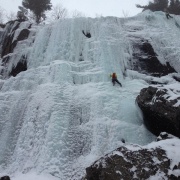
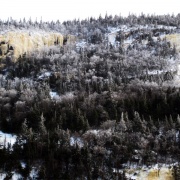
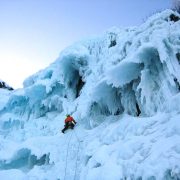
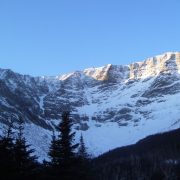
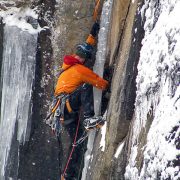

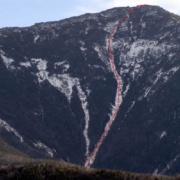

Leave a Reply
Want to join the discussion?Feel free to contribute!